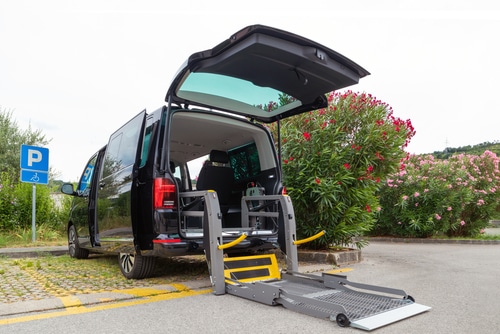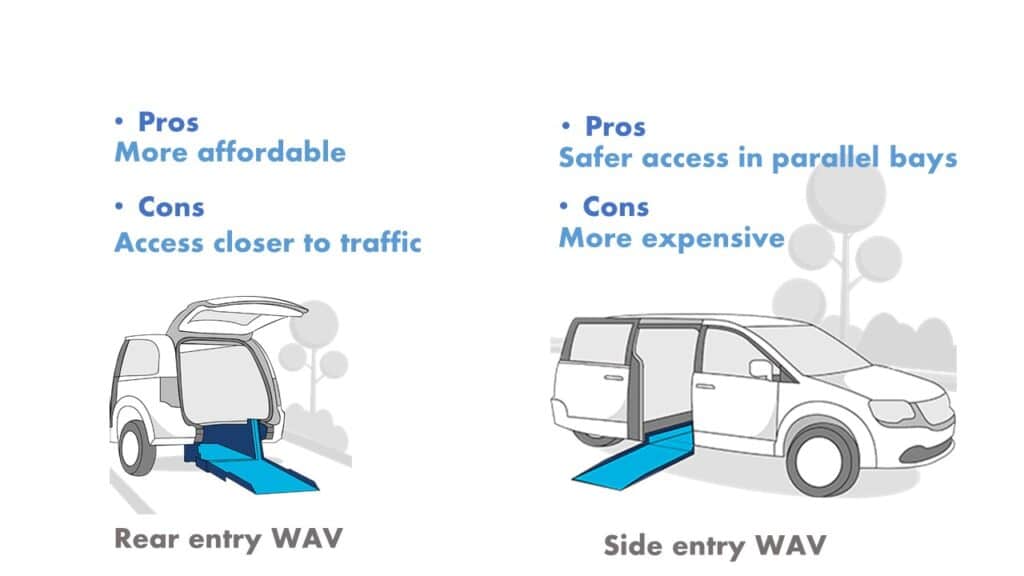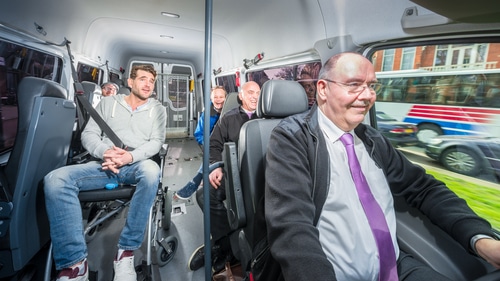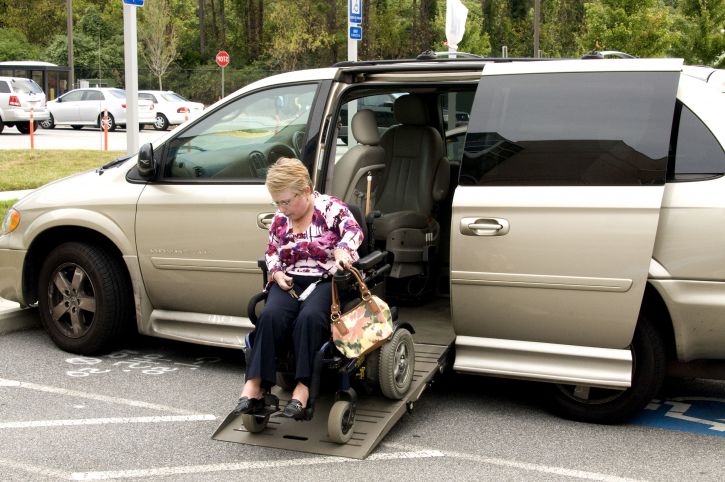In this article, we explore how wheelchair accessible vans / vehicles can support your needs as a driver or passenger with disability. We also look at how wheelchair restraints help you stay safe during travel.
Wheelchair accessible vans (also known as wheelchair accessible vehicles or WAVs for short) are structurally modified to allow a person to enter and exit the vehicle while still in their wheelchair. Of necessity wheelchair accessible vehicles are vans because they need to be big accommodate a wheelchair onboard comfortably.
For many drivers or passengers with limited mobility, this can make travel more accessible.
Transfers from wheelchair to car place a lot of load stress on the shoulder, wrist and more, however with wheelchair accessible vehicles this isn’t the case. Instead a person can access the vehicle in their wheelchair and either stay in the wheelchair or transfer to one of the car seats. Modifications can also allow a person to drive the vehicle still in the wheelchair.

Wheelchair accessible vehicles: Access and transfers
Wheelchair accessible vehicles can be tailored to every driver or passenger with a disability. How you access your vehicle depends on your mobility needs, your wheelchair type and size, your vehicle and your parking space. You can either choose between a wheelchair lift or wheelchair ramps for cars.
If you have a preferred access method, this can help you decide which base vehicle to buy as well as what modifications to make. The safest route to making these decisions is to work with a specialist occupational therapist. If you plan to use converted car modifications for drivers with disability you’ll need a driver trained occupational therapist assessment.
Rear and side entry wheelchair accessible vehicles
Wheelchair accessible vehicles come in two primary designs based on your access point. Rear and side entry WAVs each are better suited to certain parking spaces and transfer methods. For this reason it’s a good idea to try out each WAV and transfer method with the guidance of a driver trained occupational therapist prior to making a purchase.
| Side entry WAVs | Side entry wheelchair adapted vehicles use a ramp, lift or hoist to allow the wheelchair user to enter the vehicle. You can then remain in your wheelchair and sit in the first or second row position depending on your preference. |
| Rear entry WAVs | Rear entry vehicles are generally cheaper than side entry ones because fewer modifications are required. These vehicle conversions have a range of different ground clearance levels and this should be considered and tried before purchasing. Rear entry conversions allow you to enter from the back of the vehicle in your wheelchair and sit in the front, second or third row depending on your preference. |
|---|

Questions to ask when choosing a WAV
Try out parking and transferring in places you’ll need to park most often – like at home or where you work, for example. This gives you the chance to check whether you can comfortably access your vehicle and troubleshoot any issues you may encounter. If you’re thinking about your carbon footprint, read our article on assistive technology for more on electric wheelchair cars.
In addition to access methods, also speak to your occupational therapist and supplier about different mobility equipment and wheelchair car storage for road trips.
Here’s a list of other things to discuss with your occupational therapist/supplier when buying or modifying wheelchair accessible vehicles:
5 talking points for your driver trained occupational therapist
| Parking | Where do you park at home and in general and how wide or long is your parking space? Is there enough room to accommodate your preferred method of accessing your vehicle? Your parking can affect your choice between a side and rear access WAV. |
| Wheelchair | The proportions of your wheelchair need to be taken into account when choosing how you enter the vehicle. For example, it may be harder to access the wheelchair adapted vehicle in a manual wheelchair using a ramp, in which case you might choose a lift. Check if your chosen vehicle can support your preferred access method and whether side or rear entry is more compatible for it. If you plan to use your wheelchair in your car, speak with both your OT and vehicle converter so they take into account your wheelchair’s specifications. Its type, size and weight will impact a variety of car conversions, like restraints, ramps, seating systems, storage and more. |
|---|---|
| Headroom | You must be able to enter and exit safely without having to bend or duck your head. Structural modifications can be done to raise the roof to give enough headroom for safe access. If you plan to do this type of structural modification, make sure your wheelchair adapted vehicle won’t be tall for the places you regularly park in. Consider how much headroom you need based on your own height and your wheelchair type. A powered wheelchair has a battery under the seat so it’s very likely taller than a manual wheelchair. This affects what vehicle you choose and how much headroom you need. |
| Storage | Certain forms of mobility equipment storage, such as trailers, tow bar mounted carriers and external storage boxes, while very useful, can extend the length of a vehicle. If you are considering one of these options you should take your parking requirements into account. |
| Ground clearance | Consider how much ground clearance you’ll need to safely access your vehicle while in your wheelchair. |
Wheelchair restraints

Wheelchair restraints are fitted into wheelchair accessible vans to allow a person in a wheelchair to be safely secured while travelling.
Travelling in a car in your wheelchair puts you at added risk of injury in case of an accident. Even a sudden turn around a bend could cause your wheelchair to topple with you in it if it’s not fastened securely. One way to limit this risk is using wheelchair restraints. They’ll help keep you and your wheelchair in position while travelling.
Wheelchair restraints are available to suit both manual and powered wheelchairs and can be used to allow people to travel in the driver’s seat, front passenger seats or back seats.
For maximum safety, they should be used together with occupant restraint systems. By this we mean lap or sash belts that protect the user in the same way seat belts do. They are attached to the WAV and separate from any postural harnesses attached to the wheelchair. When fitting your lap or sash belt, ensure it fits snugly across your waist and chest.
There are two main types of restraints available:
1. Tie-down systems
Tie-down systems are the most commonly available and cheapest wheelchair restraint system. Four-point systems are most widely used, whereby the wheelchair is firmly secured to the car floor via four restraints that attach directly to the chair.
In the case of an accident or sudden stop, most of the forward momentum of the wheelchair and its occupant is directed downward, into the floor of the car. This limits the stress on the passenger’s body. A retractor system can be used in conjunction with the tie-down wheelchair system to reduce the time it takes to secure the restraint.

2. Wheelchair docks
Wheelchair docks are mechanical lock down systems. Docking plates attach to the floor of the wheelchair accessible vehicle and to the bottom of the wheelchair. Although they can be fitted to both power or manual wheelchairs they’re not compatible with all. Speak to your vehicle converter to see if wheelchair docks are a suitable option for your wheelchair.
Unlike tie-down systems, wheelchair docks don’t require any bending or kneeling so they’re generally quicker to use. This makes them the better option if your carer has limited mobility. These systems often come with quick release buttons and other automatic features.
Wheelchair docks are a great choice for people who wish to drive independently. Why? Because they don’t require the assistance of a carer to use them.
Side note: Ever wondered whether an electric car for wheelchair users is a real thing, or whether the only choice is just standard fuel models? Read this ‘Are Electric Cars for Wheelchair Users a Reality or Not?‘ article for more information.
Insurance for wheelchair accessible vans
Wheelchair adapted vehicles are a major investment that gives a person great independence and mobility. If you have a WAV, protect it with specialist quality car insurance for wheelchair accessible vehicles and disability converted cars that includes cover for assistive technology in your vehicle.
Click below to get started on a quote.








